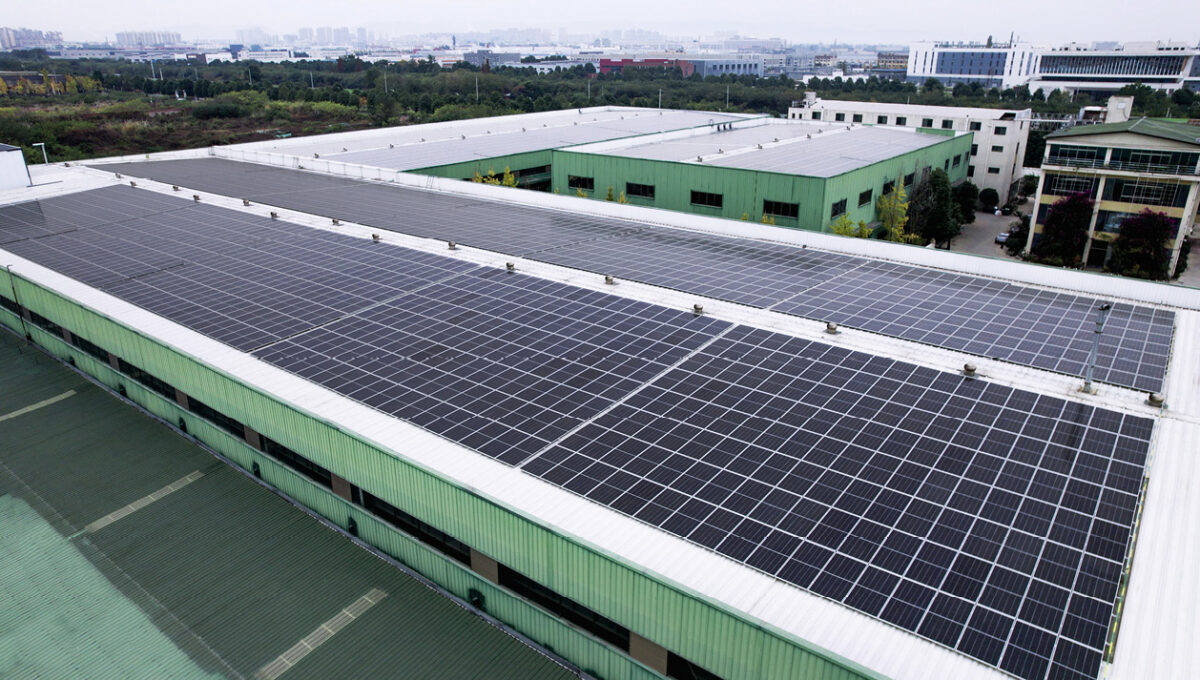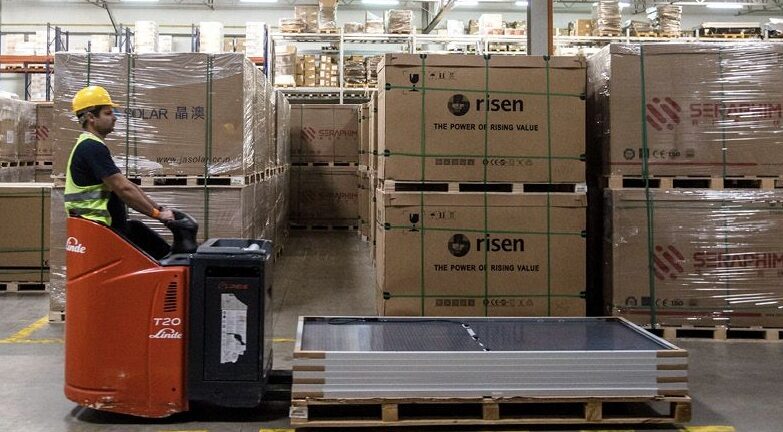From pv magazine 04/25
On Jan. 21, China’s National Energy Administration (NEA) revealed the nation had added a record 277 GW of solar in 2024. This was up 28% on 2023’s 216 GW, bolstering China’s world-leading solar status.
A dive into key data and ongoing market trends reveals underlying concerns, however, particularly for 2025. Projections suggest a potential decline in solar installations, especially in the small-scale, distributed solar segment.
In 2022, distributed PV accounted for 58% of China’s total solar capacity. In China, most PV installations smaller than 6 MW fall into the NEA’s definition of distributed PV, and it can include systems up to 50 MW depending on grid access conditions. The following year, the overall share of distributed PV fell to 45%, largely due to the explosive growth in utility-scale projects, despite the fact that projects up to 50 MW in size can still be classed as distributed if they connect to low-voltage grids. Even though the overall share of distributed systems became smaller, their absolute volume still saw year-on-year growth.
In the first half of 2024, the share of distributed solar installations was 52% but by the second half, that had dropped to 38%.
Solar surge
China’s surge in solar installations during 2023 and 2024 can be attributed to several factors. The collapse of polysilicon prices led to significant cost reductions across the solar supply chain, with module prices dropping from CNY 2 ($0.27)/W of generation capacity in 2020 to CNY 0.70/W in 2024, bringing installation costs down 40% to 50%.
State-owned energy giants such as State Power Investment Corp. (SPIC), China Energy Group, and Huaneng Energy also ramped up investment in distributed solar to meet the country’s 14th five-year plan goals, which stipulate an increase in renewable energy capacity. Those enterprises not only invested heavily in new distributed projects but also bought up existing ones to meet their targets. That led many private companies to rapidly develop and construct new projects that could be sold to state-owned energy companies. Installation figures were also boosted by the completion of projects that were delayed by the 2020-22 pandemic period.
In 2020, Chinese President Xi Jinping set ambitious carbon-neutrality targets for 2030 and 2060 that later became central to the country’s energy strategy. Under the guidance of the National Development and Reform Commission and the NEA, those goals developed into a 1.2 TW target for renewable energy installations, by 2030 and covering both wind and solar. By the end of 2024, however, China had already reached 890 GW of solar capacity and 520 GW of wind power – totaling 1.4 TW – surpassing the target six years ahead of schedule. Reaching those goals early was a significant achievement, but it also meant the resources and policies designed to support the growth had been consumed six years earlier than expected, making future growth more challenging.
Key hurdles
Residential PV in China saw a significant decline in 2024. According to the NEA, only 6.9 GW of residential PV capacity was added in the first quarter of 2024, down 23% from the first quarter of 2023. That marked the first year-on-year drop in five years. The decline became steeper in the second and third quarters, with decreases of 26% in residential and 39% in commercial projects. Residential PV’s share of total distributed installations also dropped, from a high of 75% to around 25% over the second half of 2024.
The primary cause of the decline is growing restrictions on grid connection due to the intermittent availability of renewable electricity from wind and solar. Many regional governments, including those in Shandong, Hebei, and Henan, have designated large areas as “yellow” or “red” zones, limiting the ability of residential PV projects to connect to the grid. Additionally, policy changes in provinces such as Shandong and Jiangxi have imposed stricter requirements for rooftop solar projects, reducing access to government incentives and forcing more residential users to participate in grid regulation programs.
Commercial and industrial distributed PV, which typically involves larger investment from businesses, is also facing multiple challenges. Since 2024, the grid connection restrictions that initially targeted residential PV have also begun to impact commercial projects. In provinces including Hubei, Hunan, and Guangdong, many local governments have suspended the approval of new distributed solar projects due to grid capacity limits.
For provinces without direct project suspensions, authorities have introduced market-driven measures such as adjusting floor and peak electricity prices on local grids, impacting both the cost of purchasing grid electricity and the revenue available from solar power exported to the grid. Those pricing adjustments disrupt the financial models for distributed solar projects before construction, causing developers to reconsider their investments. In response, some of the state-owned energy giants that invested heavily have publicly announced their exit from the distributed solar market.
In several regions, there has also been a direct adjustment to the guaranteed purchase hours for existing projects. The most notable examples are the provinces of Jiangsu, Sichuan, and Shaanxi. For instance, Jiangsu province, a major solar power hub in Eastern China, has mandated a reduction in the guaranteed annual purchase hours for PV projects to 400 hours, far below the province’s average solar utilization of 1,050 hours, as stipulated by rules. That means guaranteed purchase amounts now cover less than 40% of expected PV project output, reducing the stability of revenue from PV projects and forcing a larger portion of generated electricity to be sold on the spot market. That means generally lower prices and even exposure to negative prices during peak generation periods.
Similarly, Sichuan and Shaanxi have significantly reduced their guaranteed purchase hours to 300 and 293 hours, respectively. This appears to be in direct contradiction of the full guaranteed purchase and pricing clauses set out in China’s Renewable Energy Law, though flexibility and compromises are typically allowed to take into account different regional situations.
As the outlook for distributed solar worsens, many are halting their projects. SPIC has transferred the ownership of numerous solar projects with a combined value in the hundreds of millions of yuan. Other state-owned enterprises, including State Grid and Three Gorges New Energy, are also looking to sell their solar assets, often at a discount, signaling growing concern over the sector’s profitability.
New technology
Innovations such as grid-forming energy storage (GFES) and virtual power plants (VPPs) have been touted as potential solutions to stabilize the market but they still face significant challenges to operation at scale. GFES, while offering improvements over traditional, grid-following storage systems, is more expensive and technically demanding to implement. A lack of unified technical standards and protocols further complicates system integration. Similarly, VPPs, despite receiving policy backing from the NEA in June 2024, are still struggling with unclear business models, regulatory challenges, and data privacy concerns, limiting their immediate impact.
The rapid growth of China’s solar sector from 2023 to 2024 has strained critical resources, including financial capital, grid capacity, and government support. The industry faces a difficult process to solve major oversupply in the manufacturing sector and to balance its grids to enable more intermittent renewables to enter the mix. Coupled with regulatory and market shifts, distributed PV installation figures in China could see another significant decline in 2025. This year is expected to be a period of adjustment for the distributed PV segment, with the possibility that utility-scale projects may begin to face similar challenges in 2026. After years of rapid expansion, the industry now faces a slowdown, with recovery likely to take two to three years.
This content is protected by copyright and may not be reused. If you want to cooperate with us and would like to reuse some of our content, please contact: editors@pv-magazine.com.



By submitting this form you agree to pv magazine using your data for the purposes of publishing your comment.
Your personal data will only be disclosed or otherwise transmitted to third parties for the purposes of spam filtering or if this is necessary for technical maintenance of the website. Any other transfer to third parties will not take place unless this is justified on the basis of applicable data protection regulations or if pv magazine is legally obliged to do so.
You may revoke this consent at any time with effect for the future, in which case your personal data will be deleted immediately. Otherwise, your data will be deleted if pv magazine has processed your request or the purpose of data storage is fulfilled.
Further information on data privacy can be found in our Data Protection Policy.